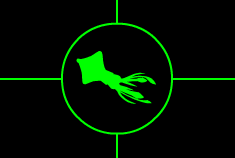
Firefly Squid
Other Names: Sparkling enope squid
Scientific Name: Watasenia scintillans
Size Range: About 3 inches
Habitat: Western Pacific Ocean
Depth Range: 600 - 1,200 feet
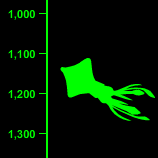
Firefly Squid
(Watasenia scintillans)
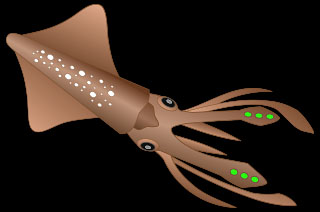 Of all the bioluminescent life forms in the deep sea, there is one tiny creature who's light show puts all others to shame. This is the firefly squid, sometimes called the sparkling enope squid. Known to science as Watasenia scintillans, it is referred to in Japan as "hotaru-ika". It is a member of the cephalopod family and is related to many other squid species throughout the world's oceans. The firefly squid gets its name from the flashing lights that resemble those of a firefly. This squid is famous for the incredible light show that occurs each year off the coast of Japan as millions of these tiny animals gather to spawn.
Of all the bioluminescent life forms in the deep sea, there is one tiny creature who's light show puts all others to shame. This is the firefly squid, sometimes called the sparkling enope squid. Known to science as Watasenia scintillans, it is referred to in Japan as "hotaru-ika". It is a member of the cephalopod family and is related to many other squid species throughout the world's oceans. The firefly squid gets its name from the flashing lights that resemble those of a firefly. This squid is famous for the incredible light show that occurs each year off the coast of Japan as millions of these tiny animals gather to spawn.
The firefly squid is a small member of the squid family, growing to a length of only three inches (seven centimeters). The squid is equipped with special light-producing organs called photophores. These photophores are found on many parts of the squid's body and emit a deep blue light. Large photophores can be found on the tips of the tentacles as well as around the eyes. Thousands of tiny photophores can be found throughout the squid's body, giving it the ability to emit light along its entire form. The lights can be flashed in unison or alternated in an endless number of animated patterns. These light shows are thought to serve several functions. They can be used to communicate with potential mates or rivals. They may also be used to disguise the squid's shape and confuse predators, allowing it to escape. The firefly squid is the only member of the squid family that is believed to have color vision. While most cephalopods have only one visual pigment, firefly squid have three. They also have a double-layered retina in the back of the eye. These adaptations for color vision may have evolved to enable firefly squid to distinguish between ambient light and bioluminescence, and to help them decode the patterns of light created by other members of the species.
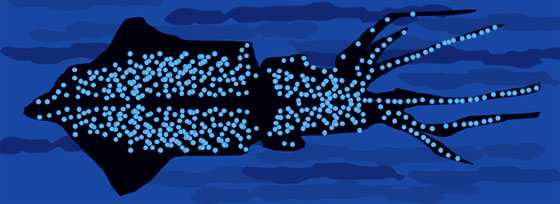
Image of firefly squid showing bioluminescent photophores
(© Chiswick Chap / CC BY-SA 4.0)
The firefly squid is an active predator. It is believed that the squid can use their blue lights to attract prey. By flashing the lights on and off, they can attract small fish and then pounce on them with their powerful tentacles. Firefly squid spend their days at depths of about 1,200 feet (365 meters). At night, they migrate up to the surface to search for food before returning the the darkness below.
The spawning season of the firefly squid runs from March to May. During this time, the squid can be seen gathering in large numbers in Toyama Bay in Japan. They gather here by the millions, and sometimes by the billions, to lay their eggs. Once the eggs have been released into the water and fertilized, the adult squid begin to die. This completes the one-year life cycle of the squid. This annual light show is so spectacular that the area where they gather has been designated as a special natural monument. Toyama Bay lies above a deep, v-shaped canyon in which the sea floor drops away suddenly. The flow of the ocean currents usually wells up from the bottom of this canyon and pushes the squid to the surface. Occasionally the squid can be found washed up on the shore in large numbers during a phenomenon referred to by locals as "squid drowning themselves". This event can cover the shoreline for miles, bathing the beaches in an erie blue glow.
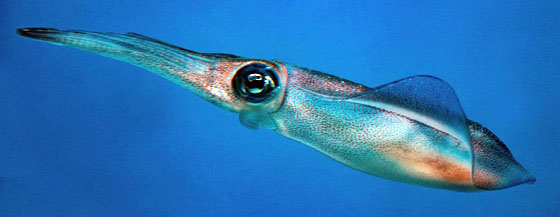
Firefly squid swimming in the ocean
(© Circe Denyer / CC0)
Firefly squid are found throughout the western Pacific Ocean where they can typically be found at depths ranging from 600 to 1,200 feet (182 to 365 meters). This squid is considered a delicacy in Japan and is widely fished there during the spawning season. As fishing boats haul in their catches, the sea surface begins to glow a bright cobalt blue. The spectacle is so amazing that tourists travel with sight seeing boats just to watch the show.
Deep Sea
Creature Database
'



